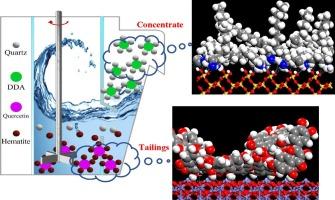Multiscale separation mechanisms of novel eco-friendly depressants in hematite reverse flotation
IF 6.9
2区 材料科学
Q2 CHEMISTRY, PHYSICAL
引用次数: 0
Abstract
This study delves into the separation mechanism of hematite from quartz in reverse flotation using quercetin as a novel eco-friendly depressant. Micro-flotation tests were combined with molecular dynamics simulations. The underlying separation mechanisms were then elucidated through multi-scale analyses, including FTIR, XPS, AFM, and optical microscopy. Results show quercetin effectively separates hematite and quartz at pH 10, yielding a TFe grade of 63.44 % and recovery of 89.72 % in the mixed ore concentrate. Compared to neutral conditions, the concentrate grade increased by 1.21 %, with the recovery rate decreasing by only 0.24 %. FT-IR analysis showed that the surface of hematite treated with quercetin, a novel eco-friendly depressant, exhibited hydroxyl group peaks characteristic of quercetin. XPS analysis further indicated that the hydroxyl groups in quercetin chemically adsorbed onto the Fe on the hematite surface. AFM analysis revealed that after treatment with quercetin, the vertical fluctuation range of the cross-sectional height of hematite was relatively large, and the hematite surface exhibited several flaky protuberances. Molecular dynamics calculations show a significant peak near 2 Å for the interaction between the –OH in quercetin and Fe on hematite, and a peak near 3 Å for the interaction between the –NH2 in DDA and O on quartz. These results are consistent with flotation tests results, indicating the accuracy of the molecular dynamics simulation calculations. This study offers an eco-efficient selective depressant for hematite and gangue mineral separation, with theoretical and practical significance for the sustainable development of clean mines.

新型环保型抑制剂在赤铁矿反浮选中的多尺度分离机理研究
研究了槲皮素作为新型环保型抑制剂反浮选赤铁矿与石英的分离机理。微浮选试验与分子动力学模拟相结合。然后通过多尺度分析,包括FTIR, XPS, AFM和光学显微镜,阐明了潜在的分离机制。结果表明:槲皮素在pH 10条件下可有效分离赤铁矿和石英,混合精矿中TFe品位为63.44%,回收率为89.72%。与中性条件相比,精矿品位提高1.21%,回收率仅下降0.24%。傅里叶变换红外光谱(FT-IR)分析表明,槲皮素处理后的赤铁矿表面呈现槲皮素特征的羟基峰。XPS分析进一步表明槲皮素中的羟基被化学吸附在赤铁矿表面的铁上。AFM分析显示,槲皮素处理后赤铁矿横截高度垂直波动范围较大,赤铁矿表面出现若干片状突起。分子动力学计算表明,槲皮素中的-OH与赤铁矿上Fe的相互作用在2 Å附近有一个显著的峰,DDA中的-NH2与石英上O的相互作用在3 Å附近有一个显著的峰。这些结果与浮选试验结果一致,表明了分子动力学模拟计算的准确性。本研究为赤铁矿和脉石矿物分离提供了一种生态高效的选择性抑制剂,对清洁矿山的可持续发展具有理论和现实意义。
本文章由计算机程序翻译,如有差异,请以英文原文为准。
求助全文
约1分钟内获得全文
求助全文
来源期刊

Applied Surface Science
工程技术-材料科学:膜
CiteScore
12.50
自引率
7.50%
发文量
3393
审稿时长
67 days
期刊介绍:
Applied Surface Science covers topics contributing to a better understanding of surfaces, interfaces, nanostructures and their applications. The journal is concerned with scientific research on the atomic and molecular level of material properties determined with specific surface analytical techniques and/or computational methods, as well as the processing of such structures.
 求助内容:
求助内容: 应助结果提醒方式:
应助结果提醒方式:


